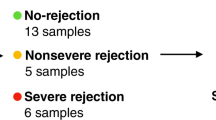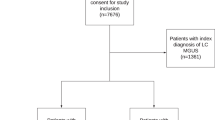Abstract
Cord blood transplantation (CBT) is frequently associated with pre-engraftment immune reaction (PIR), which is characterized by high-grade fever that peaks around day 9 of transplantation. PIR mimics hyperacute GVHD or engraftment syndrome; however, it is considered to be of different etiology as it occurs before engraftment. Proteomic patterns have been studied in the fields of transplantation, but no specific marker has been identified. As there are no data to confirm the mechanism of PIR, we used a surface-enhanced laser desorption/ionization time-of-flight mass spectroscopy (SELDI-TOF MS) system to identify a specific marker for PIR. The protein expression profile of serum samples from CBT patients was analyzed with a SELDI-TOF MS system. A protein peak that commonly predominated in PIR was purified by an anion exchange column, isolated by SDS-PAGE, and identified by in-gel trypsin digestion, and mass fingerprinting. A 8.6-kDa protein and 11-kDa protein that increased by 10- to 100-fold in the serum of patients during PIR was identified as anaphylatoxin C4a and serum amyloid A. SELDI-TOF MS system in combination with other proteomic methods could serve as a potential diagnostic tool in discovering biomarkers for PIR after CBT.
This is a preview of subscription content, access via your institution
Access options
Subscribe to this journal
Receive 12 print issues and online access
$259.00 per year
only $21.58 per issue
Buy this article
- Purchase on Springer Link
- Instant access to full article PDF
Prices may be subject to local taxes which are calculated during checkout




Similar content being viewed by others
References
Kishi Y, Kami M, Miyakoshi S, Kanda Y, Murashige N, Teshima T et al. Early immune reaction after reduced-intensity cord-blood transplantation for adult patients. Transplantation 2005; 80: 34–40.
Miyakoshi S, Yuji K, Kami M, Kusumi E, Kishi Y, Kobayashi K et al. Successful engraftment after reduced-intensity umbilical cord blood transplantation for adult patients with advanced hematological diseases. Clin Cancer Res 2004; 10: 3586–3592.
Uchida N, Wake A, Takagi S, Yamamoto H, Kato D, Matsuhashi Y et al. Umbilical cord blood transplantation after reduced-intensity conditioning for elderly patients with hematologic diseases. Biol Blood Marrow Transplant 2008; 14: 583–590.
Takahashi S, Iseki T, Ooi J, Tomonari A, Takasugi K, Shimohakamada Y et al. Single-institute comparative analysis of unrelated bone marrow transplantation and cord blood transplantation for adult patients with hematologic malignancies. Blood 2004; 104: 3813–3820.
Narimatsu H, Terakura S, Matsuo K, Oba T, Uchida T, Iida H et al. Short-term methotrexate could reduce early immune reactions and improve outcomes in umbilical cord blood transplantation for adults. Bone Marrow Transplant 2007; 39: 31–39.
Mori T, Aisa Y, Nakazato T, Yamazaki R, Shimizu T, Mihara A et al. Tacrolimus and methotrexate for the prophylaxis of graft-versus-host disease after unrelated donor cord blood transplantation for adult patients with hematologic malignancies. Transplant Proc 2007; 39: 1615–1619.
Heike Y, Hosokawa M, Osumi S, Fujii D, Aogi K, Takigawa N et al. Identification of serum proteins related to adverse effects induced by docetaxel infusion from protein expression profiles of serum using SELDI ProteinChip system. Anticancer Res 2005; 25: 1197–1203.
Srinivasan R, Daniels J, Fusaro V, Lundqvist A, Killian JK, Geho D et al. Accurate diagnosis of acute graft-versus-host disease using serum proteomic pattern analysis. Exp Hematol 2006; 34: 796–801.
Weissinger EM, Mischak H, Ganser A, Hertenstein B . Value of proteomics applied to the follow-up in stem cell transplantation. Ann Hematol 2006; 85: 205–211.
Kaiser T, Kamal H, Rank A, Kolb HJ, Holler E, Ganser A et al. Proteomics applied to the clinical follow-up of patients after allogeneic hematopoietic stem cell transplantation. Blood 2004; 104: 340–349.
Weissinger EM, Schiffer E, Hertenstein B, Ferrara JL, Holler E, Stadler M et al. Proteomic patterns predict acute graft-versus-host disease after allogeneic hematopoietic stem cell transplantation. Blood 2007; 109: 5511–5519.
El Essawy B, Otu HH, Choy B, Zheng XX, Libermann TA, Strom TB . Proteomic analysis of the allograft response. Transplantation 2006; 82: 267–274.
Yamayoshi Y, Watanabe T, Tanabe M, Hoshino K, Matsumoto K, Morikawa Y et al. Novel application of ProteinChip technology exploring acute rejection markers of rat small bowel transplantation. Transplantation 2006; 82: 320–326.
Albitar M, Potts SJ, Giles FJ, O'Brien S, Keating M, Thomas D et al. Proteomic-based prediction of clinical behavior in adult acute lymphoblastic leukemia. Cancer 2006; 106: 1587–1594.
Koopmann J, Zhang Z, White N, Rosenzweig J, Fedarko N, Jagannath S et al. Serum diagnosis of pancreatic adenocarcinoma using surface-enhanced laser desorption and ionization mass spectrometry. Clin Cancer Res 2004; 10: 860–868.
Wong YF, Cheung TH, Lo KW, Wang VW, Chan CS, Ng TB et al. Protein profiling of cervical cancer by protein-biochips: proteomic scoring to discriminate cervical cancer from normal cervix. Cancer Lett 2004; 211: 227–234.
Yang SY, Xiao XY, Zhang WG, Zhang LJ, Zhang W, Zhou B et al. Application of serum SELDI proteomic patterns in diagnosis of lung cancer. BMC Cancer 2005; 5: 83.
Ward DG, Suggett N, Cheng Y, Wei W, Johnson H, Billingham LJ et al. Identification of serum biomarkers for colon cancer by proteomic analysis. Br J Cancer 2006; 94: 1898–1905.
Malik G, Ward MD, Gupta SK, Trosset MW, Grizzle WE, Adam BL et al. Serum levels of an isoform of apolipoprotein A-II as a potential marker for prostate cancer. Clin Cancer Res 2005; 11: 1073–1085.
Tolson J, Bogumil R, Brunst E, Beck H, Elsner R, Humeny A et al. Serum protein profiling by SELDI mass spectrometry: detection of multiple variants of serum amyloid alpha in renal cancer patients. Lab Invest 2004; 84: 845–856.
Le L, Chi K, Tyldesley S, Flibotte S, Diamond DL, Kuzyk MA et al. Identification of serum amyloid A as a biomarker to distinguish prostate cancer patients with bone lesions. Clin Chem 2005; 51: 695–707.
Niemi K, Baumann MH, Kovanen PT, Eklund KK . Serum amyloid A (SAA) activates human mast cells which leads into degradation of SAA and generation of an amyloidogenic SAA fragment. Biochim Biophys Acta 2006; 1762: 424–430.
Uhlar CM, Whitehead AS . Serum amyloid A, the major vertebrate acute-phase reactant. Eur J Biochem 1999; 265: 501–523.
Salazar A, Pinto X, Mana J . Serum amyloid A and high-density lipoprotein cholesterol: serum markers of inflammation in sarcoidosis and other systemic disorders. Eur J Clin Invest 2001; 31: 1070–1077.
Katayama T, Nakashima H, Takagi C, Honda Y, Suzuki S, Iwasaki Y et al. Serum amyloid a protein as a predictor of cardiac rupture in acute myocardial infarction patients following primary coronary angioplasty. Circ J 2006; 70: 530–535.
Katayama T, Nakashima H, Honda Y, Suzuki S, Yamamoto T, Iwasaki Y et al. The relationship between acute phase serum amyloid A (SAA) protein concentrations and left ventricular systolic function in acute myocardial infarction patients treated with primary coronary angioplasty. Int Heart J 2007; 48: 45–55.
Muller TF, Trosch F, Ebel H, Grussner RW, Feiber H, Goke B et al. Pancreas-specific protein (PASP), serum amyloid A (SAA), and neopterin (NEOP) in the diagnosis of rejection after simultaneous pancreas and kidney transplantation. Transpl Int 1997; 10: 185–191.
Maury CP, Teppo AM, Ahonen J, von Willebrand E . Measurement of serum amyloid A protein concentrations as test of renal allograft rejection in patients with initially non-functioning grafts. Br Med J (Clin Res Ed) 1984; 288: 360–361.
Hartmann A, Eide TC, Fauchald P, Bentdal O, Herbert J, Gallimore JR et al. Serum amyloid A protein is a clinically useful indicator of acute renal allograft rejection. Nephrol Dial Transplant 1997; 12: 161–166.
Fukuda Y, Hoshino S, Tanaka I, Yoneya T, Takeshita T, Sumimoto R et al. Examination of serum amyloid A protein in kidney transplant patients. Transplant Proc 2000; 32: 1796–1798.
Feussner G, Stech C, Dobmeyer J, Schaefer H, Otto G, Ziegler R . Serum amyloid A protein (SAA): a marker for liver allograft rejection in humans. Clin Investig 1994; 72: 1007–1011.
Muller TF, Vogl M, Neumann MC, Lange H, Grimm M, Muller MM . Noninvasive monitoring using serum amyloid A and serum neopterin in cardiac transplantation. Clin Chim Acta 1998; 276: 63–74.
Vermes E, Kirsch M, Farrokhi T, Loisance D, Fanen P, Zimmermann R . Serum amyloid A protein: not a relevant marker for recognition of cardiac allograft rejection. Transplantation 2004; 78: 950–951.
Fuji S, Kim SW, Fukuda T, Mori S, Yamasaki S, Morita-Hoshi Y et al. Preengraftment serum C-reactive protein (CRP) value may predict acute graft-versus-host disease and nonrelapse mortality after allogeneic hematopoietic stem cell transplantation. Biol Blood Marrow Transplant 2008; 14: 510–517.
Acknowledgements
This work was supported in part by grants from the Ministry of Health, Labor and Welfare, Japan.
Author information
Authors and Affiliations
Corresponding author
Ethics declarations
Competing interests
The authors declare no conflict of interest.
Rights and permissions
About this article
Cite this article
Morita-Hoshi, Y., Mori, SI., Soeda, A. et al. Identification of molecular markers for pre-engraftment immune reactions after cord blood transplantation by SELDI-TOF MS. Bone Marrow Transplant 45, 1594–1601 (2010). https://doi.org/10.1038/bmt.2010.18
Received:
Revised:
Accepted:
Published:
Issue Date:
DOI: https://doi.org/10.1038/bmt.2010.18
Keywords
This article is cited by
-
Pre-engraftment syndrome after myeloablative dual umbilical cord blood transplantation: risk factors and response to treatment
Bone Marrow Transplantation (2013)



